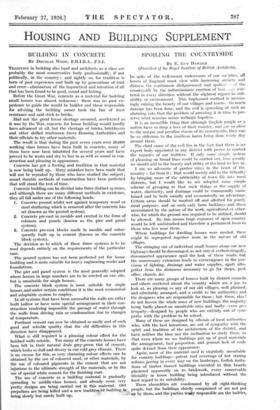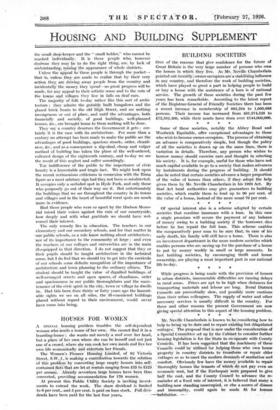SPOILING THE COUNTRYSIDE
BY E. Guy DAWBER
(President of the Royal Institute of British Architects).
IN spite of the well-meant endeavours of our societies, all lovers of England must view with increasing anxiety and distress the continuous disfigurement and spoliai i of the countryside by the indiscriminate erection of buil.....gs scat- tered in every direction without the slightest regard to suit- ability or environment. This haphazard method is increas- ingly ruining the beauty of our villages and towns. So much damage has been done, and the evil is spreading at such an alarming rate, that the problem of arresting it in time to pre- serve what remains seems wellnigh hopeless.
It is an incredible thing that although English people as a nation have so deep a love of their country, and are so alive to the unique and peculiar charm of its countryside, they can be so oblivious to the insidious harm being done every day around them.
The chief cause of the evil lies in the fact that there is no expert body appointed in any district with power to control the vagaries of our builders. If only some simple system of planning on broad lines could be carried out, how greatly we should add to the beauty and utility of the land we live in.
I am no advocate of garden cities in the heart of the country : far from it ; that would merely add to the difficulty by bringing more of the artificiality of town life into rural districts, but I would like to see adopted some simple scheme of grouping so that such things as the supply of water, electricity, and drainage could be communally main- tained and be both socially and economically an advantage. Certain areas should be marked off and allotted for purely rural purposes, and on such only farm buildings and those necessitated by the nature of the work, agricultural cr other- wise, for which the ground was required to be utilized, should be allowed. By this means large expanses of open country would be left undisturbed and therefore a permanent boon to those who live near them.
Where buildings for dwelling houses were needed, these might be segregated together more in the nature of old villages.
The stringing out of individual small houses along our new highways should be discouraged, as not only does their straggly, -disconnected appearance spoil the look of these roads, but the unnecessary extension tends to extravagance in the pro- vision of lighting, drainage and water supplies, apart alto- gether from the distances necessary to go for shops, post office, church, &e.
There are many groups of houses built by district councils and others scattered about the country which are a joy to look at, as pleasing as any of our old villages, well planned, and admirably arranged, and a credit to the authorities and the designers who are responsible for them ; but these, alas ! do not leaven the whole mass of new buildings, the majority being badly placed on unsuitable sites and badly—even grc- tesquely—designed by people who are entirely out of sym- pathy with the probleM to be solved.
Many of these are designed by officials of local authorities who, with the best intentions, are out of sympathy with the spirit and tradition of the architecture of the district, and have neither the time nor the inclination to study them, so that even where we see buildings put up of good materials the arrangement, bad proportion, and general lack of scale quite detract from their appearance. Again, most of the material used is singularly unsuitable for country buildings—patent roof coverings of hot staring colours jarring in every way on the landscape, foolish imita- tions of timber framed buildings executed in thin boards plastered apparently on to brickwork, every conceivable triviality in house building being introduced without the least regard to its suitability.
These absurdities are condemned by all right-thinking people, but the buildings chiefly complained of are not put '.up by them, and the parties really responsible are the builder, the small shop-keeper and the small holder," who cannot be reached individually. ' It is these people who, however desirous they may be to do the right thing, are, by lack of understanding, ruining the appearance of whole districts.
Unless the 4-peal to -these people is through the pocket— that -iss 'unless they-are-made to realize that by their very action they, are driving away people from the country and incidentally'tbe, money they spend—no great progress will be made, for any appeal to their artistic sense and to the ruin of the towns and_ villages they live in falls on deaf ears.
The majority of folk to-day rather like this sort of archi- tecture ; they admire the garishly built bungalows and the glazed brick fronts to the old High Street, and see nothing incongruous or out of place, and until the advantages, both financially and socially, of good buildings, well-planned houses, &e., are brought home to them nothing will be done.
They say a country deserves the Government it gets : cer- tainly it is the case with its architecture. For more than a century no attempt has been made to make the public see the advantages of good buildings, spacious streets, order, cleanli- ness, &e., and as a consequence a slip-shod, cheap and vulgar method of building has taken the place of the well-ordered, cultured design of the eighteenth century, and to-day we see the result of this neglect and suffer accordingly.
The indifference of the public to the importance of civic beauty is a lamentable and tragic fact. We might look upon the recent acrimonious criticisms in connexion with the Rima figure as a most salutary sign had they not been so misdirected. It occupies only a secluded spot in Hyde Park, and only those who purposely go out of their way see it. But unfortunately the buildings that we see throughout the country in its towns and villages and in the heart of beautiful rural spots are much more in evidence.
Had those people who were so upset by the Hudson Memo- rial raised their voices against the ruin of our countryside, how deeply and with what gratitude we should have wel- comed their interest.
The only remedy lies in education. The teachers in our elementary and our secondary schools, and for that matter in our public schools, as a rule know nothing about architecture, 'nor of its importance to the community at large ; and even the teachers at our colleges and universities are in the main ill-equipped in that direction. I do not suggest that they or their pupils shduld be taught architecture in the technical sense, but I do feel that we should try to get into the curricula of our schools some definite recognition of the importance of - architecture and town planning to the ordinary citizen. The student should be taught the value of dignified buildings, of well-arranged streets and open spaces, of cleanliness, order and spaciousness in our public thoroughfares and the main- tenance of the civic spirit in the city, town or village he dwells in.. Had this been done thirty or forty years ago the lament- able sights we see on all sides, the ill-considered buildings placed without regard to their environment, would never have come into being.























































 Previous page
Previous page